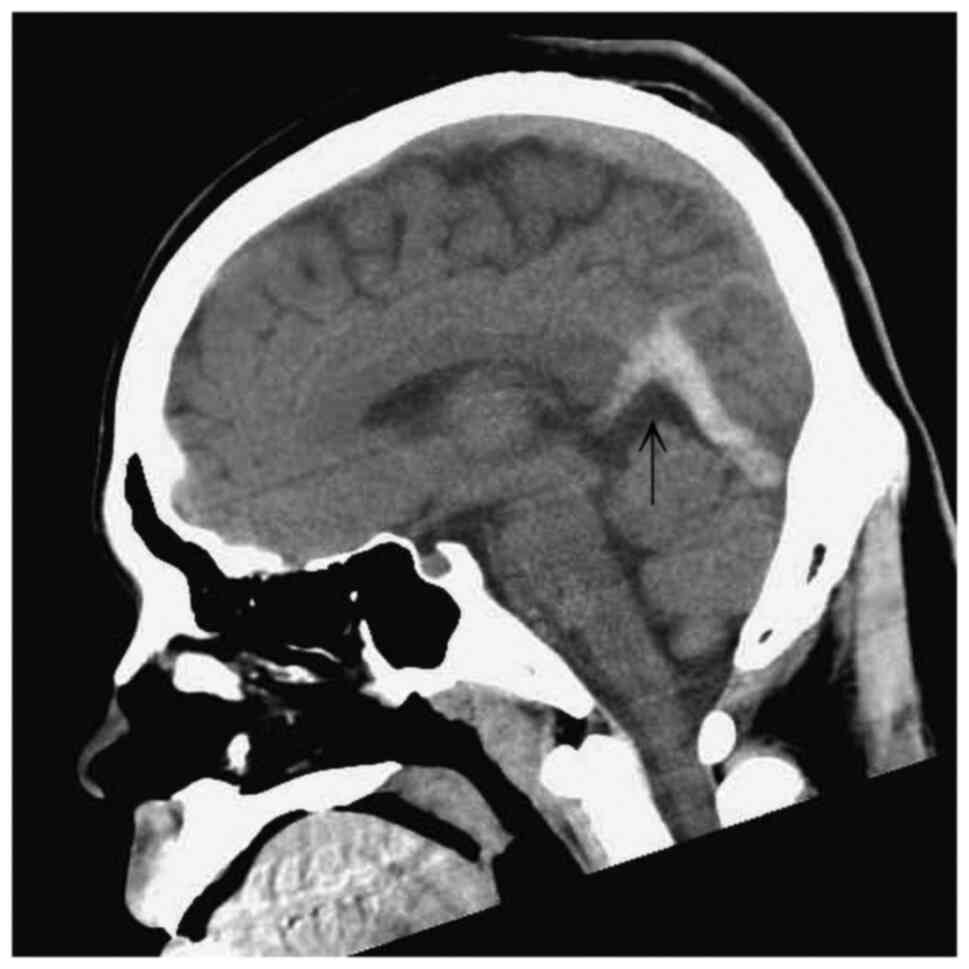
A nitrous oxide abuser presenting with cerebral venous thrombosis: A case report
- Authors:
- Shum-Shin Lin
- I-Wei Fan
- Chun-Yu Chen
- Yu-Jang Su
View Affiliations
Affiliations: Department of Emergency Medicine, Tao‑Yuan General Hospital, Taoyuan City 330, Taiwan, R.O.C., Department of Neurology, Neurological Institute, Taipei Veterans General Hospital, Taipei 112201, Taiwan, R.O.C., Department of Emergency Medicine, Mackay Memorial Hospital, Taipei 10449, Taiwan, R.O.C.
- Published online on: June 7, 2022 https://doi.org/10.3892/mi.2022.45
-
Article Number:
20
-
Copyright: © Lin
et al. This is an open access article distributed under the
terms of Creative
Commons Attribution License.
Metrics: Total
Views: 0 (Spandidos Publications: | PMC Statistics: )
Metrics: Total PDF Downloads: 0 (Spandidos Publications: | PMC Statistics: )
This article is mentioned in:
Abstract
The present study describes the case of a 25‑year‑old male patient who presented to the emergency department with severe headache and vertigo lasting for 3 days. The patient did not have a recent history of trauma. He was vaccinated with a second dose of the AstraZeneca COVID‑19 vaccine ~1 month prior, and he suffered from a vitamin B12 deficiency due to nitrous oxide abuse. Upon an examination of his vital signs, he was found to have a body temperature of 36.4˚C, a pulse rate of 64 beats per minute, a respiratory rate of 18 breaths per minute and a blood pressure of 119/68 mmHg. A neurological examination only revealed left homonymous upper quadrantanopia. The serum platelet count of the patient was 361x1,000/µl and he had elevated D‑dimer levels (0.98 µg/ml). A provisional clinical diagnosis of acute cerebrovascular accident was made. A computed tomography scan of the head revealed an abnormal hyperattenuation in the straight sinus and bilateral transverse sinuses. A diagnosis of cerebral sinovenous thrombosis (CSVT) was made following a consultation with a neurologist. The patient was treated with enoxaparin at 6,000 IU, levetiracetam at 1,000 mg and mannitol at 100 ml via an intravenous drip. After admission, magnetic resonance venography revealed the absence of flow in the straight sinus and bilateral transverse sinuses. A thrombophilic investigation revealed a plasma homocysteine level of 59.03 µmol/l (upper normal limit, 15.39 µmol/l), a vitamin B12 level of <148 (lower normal limit, 187 pg/ml). CSVT secondary to homocystinemia was diagnosed. The treatment included anticoagulation and vitamin B12 supplementation. The patient was administered vitamin B12 at 500 mcg twice per day, pyridoxine at 50 mg per day, folic acid at 5 mg two times per day and edoxaban at 60 mg per day. After 7 days of treatment, his headache and quadrantanopia were improved, and the patient was discharged.
View References
|
1
|
Qureshi MIA, Azam B, Waheed MA and Imran
A: Venous sinus thrombosis after the first dose of Pfizer BioNTech
vaccine. BMJ Case Rep. 15(e247493)2022.PubMed/NCBI View Article : Google Scholar
|
|
2
|
Ornelas-Aguirre JM, Gómez-Alcalá AV and
Ramírez-Leyva DH: Increment of D-dimer Associated with Immune
Thrombotic Thrombocytopenia in ChAdOx1 nCoV-19 Vaccinated
Individuals. Arch Med Res. 53:341–351. 2022.PubMed/NCBI View Article : Google Scholar
|
|
3
|
Rasyid A, Mesiano T, Kurniawan M, Hidayat
R, Mulyadi R, Nugroho SW, Yolanda S, Wiyarta E and Harris S:
Spontaneous subarachnoid hemorrhage due to arteriovenous
malformation mimicking migraine: A case report. Radiol Case Rep.
17:790–793. 2021.PubMed/NCBI View Article : Google Scholar
|
|
4
|
Ohta K, Mori M, Yoritaka A, Okamoto K and
Kishida S: Delayed ischemic stroke associated with methamphetamine
use. J Emerg Med. 28:165–167. 2005.PubMed/NCBI View Article : Google Scholar
|
|
5
|
Phinney TA, Gibb GJ and Laghari FJ: CO
poisoning as an associated risk factor for CVT. Am J Emerg Med.
36:1123.e1–1123.e3. 2018.PubMed/NCBI View Article : Google Scholar
|
|
6
|
Senthilkumaran S, Balamurugan N and
Thirumalaikolandusubramanian P: Viper envenomation and cerebral
venous thrombosis. J Postgrad Med. 59:171–172. 2013.PubMed/NCBI View Article : Google Scholar
|
|
7
|
Goldstein LH, Mordish Y, Abu-Kishak I,
Toledano M and Berkovitch M: Acute paralysis following recreational
MDMA (Ecstasy) use. Clin Toxicol (Phila). 44:339–341.
2006.PubMed/NCBI View Article : Google Scholar
|
|
8
|
Alvis-Miranda HR, Milena Castellar-Leones
S, Alcala-Cerra G and Rafael Moscote-Salazar L: Cerebral Sinus
venous thrombosis. J Neurosci Rural Pract. 4:427–438.
2013.PubMed/NCBI View Article : Google Scholar
|
|
9
|
Gatt A and Makris M: Hyperhomocysteinemia
and venous thrombosis. Semin Hematol. 44:70–76. 2007.PubMed/NCBI View Article : Google Scholar
|
|
10
|
Farhat W, Pariente A and Mijahed R:
Extensive cerebral venous thrombosis secondary to recreational
nitrous oxide abuse. Cerebrovasc Dis. 51:114–117. 2022.PubMed/NCBI View Article : Google Scholar
|
|
11
|
de Valck L, Defelippe VM and Bouwman NAMG:
Cerebral venous sinus thrombosis: A complication of nitrous oxide
abuse. BMJ Case Rep. 14(e244478)2021.PubMed/NCBI View Article : Google Scholar
|
|
12
|
Perry RJ, Tamborska A, Singh B, Craven B,
Marigold R, Arthur-Farraj P, Yeo JM, Zhang L, Hassan-Smith G, Jones
M, et al: Cerebral venous thrombosis after vaccination against
COVID-19 in the UK: A multicentre cohort study. Lancet.
398:1147–1156. 2021.PubMed/NCBI View Article : Google Scholar
|
|
13
|
Pratt DN, Patterson KC and Quin K: Venous
thrombosis after nitrous oxide abuse, a case report. J Thromb
Thrombolysis. 49:501–503. 2020.PubMed/NCBI View Article : Google Scholar
|
|
14
|
Xiang Y, Li L, Ma X, Li S, Xue Y, Yan P,
Chen M and Wu J: Recreational nitrous oxide abuse: Prevalence,
neurotoxicity, and treatment. Neurotox Res. 39:975–985.
2021.PubMed/NCBI View Article : Google Scholar
|











